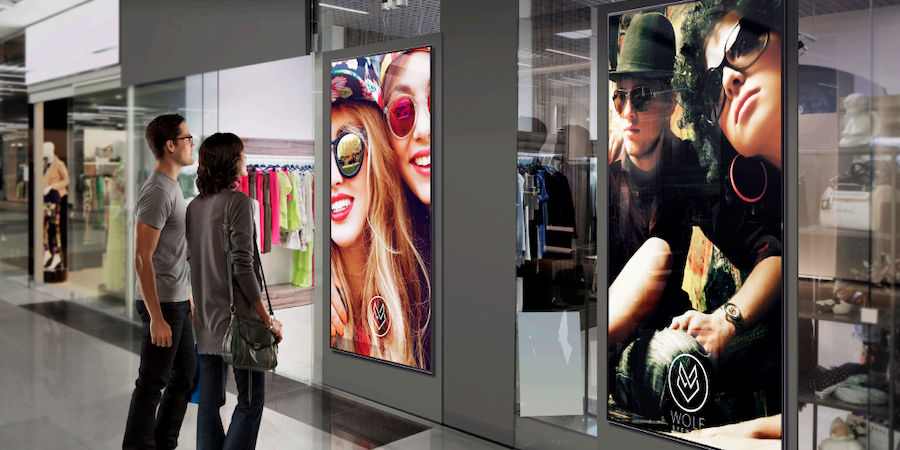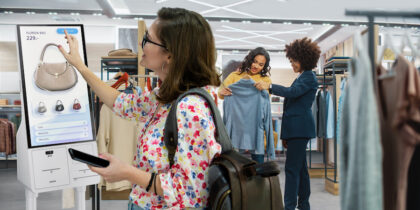Retailers have rarely had to evolve as quickly as they did in the past few years. Many retailers were already planning their digital transformation and implementing omnichannel marketing, but in the wake of the pandemic, those plans were dramatically accelerated — and post-pandemic, there are no expectations of it slowing down.
Research shows that global retail e-commerce sales are predicted to reach $5.5 trillion by the end of 2022, up from $4.9 trillion in 2021. In addition, similar research found that 33 percent of shoppers under the age of 50 who started using services like curbside pickup intend to keep using those services, even when it’s safe to shop among crowds.
Keeping up with the competition
In a digitally transformed shopping landscape, retailers are competing with brands that sell directly to customers, as well as with online marketplaces that offer vast catalogs of products and convenient one-click purchasing. Dynamic, well-positioned digital displays — conveying timely, relevant messaging — help retailers stay competitive. From self-service kiosks to interactive window displays, digital signage can deliver personalized and engaging shopping experiences while optimizing store performance.
The future of retail is digital
Get your free guide to growing your retail business by adopting future-proof ecommerce technology. Download Now
“The global pandemic has forced the retail industry to reexamine the customer journey, and optimizing store operations is paramount to success in the future,” says Parrish Chapman, Samsung’s U.S. director of sales in B2B retail.
Samsung, for example, offers new technologies and education efforts to help businesses adapt to dramatically shifting consumer behavior. The variety of innovative Samsung retail technology products and services are designed to deliver compelling in-store retail experiences — while ensuring shoppers and staff stay safe.
Addressing shopper needs and expectations
As retailers try to communicate their new store policies as effectively as possible, displays can inform, guide and motivate customers. Samsung offers a series of displays (and related technologies) built for contemporary retail needs:
Supporting self-service: The all-in-one Samsung Kiosk — a first for the company — creates a consistent check-out experience for customers while cutting down on wait time. Designed as a ready-out-of-the-box solution, retailers don’t have to deal with a complicated setup or configuration process. Samsung Kiosk features a touchscreen display, speaker, System-on-Chip (SoC) processor, stand, terminal and printer, and it’s compatible with several payment options. Touch-driven 4K displays make it easy for shoppers to navigate large stores, locate items, check inventory, and review product details and options, without needing to speak with staff directly.
Up close and personal: The QBR series of smaller displays allows retailers to put high-resolution digital signage in optimal locations, close to relevant products and their stores’ key decision points. With compact 13-inch and 24-inch displays, retailers can maintain up-to-date in-store messaging without sacrificing product space. An interactive version of the QBR displays allows customers and staff to look up product information and inventory on the spot.
Premium visuals: High-quality products with noteworthy details can be shown at their very best on Samsung’s series of 8K QLED displays or The Wall’s microLED video display. With the rich colors and deep contrast produced by quantum dots and HDR technologies, 8K displays give you the image granularity of a glossy print. You can also add motion and change the visuals on demand, or on a set schedule. The Wall’s immersive visuals captivate shoppers and create memorable experiences that drive sales.
Outward-facing screens: Samsung’s window and outdoor LED displays are highly visible, easy-to-manage tools for attracting foot traffic, promoting new offers and communicating logistical changes, such as store hours and capacity limits. For example, Panico Salon, a luxury hair salon in New Jersey, has Samsung window displays facing the street to showcase ongoing promotions and photos of their work.
Pro TVs: Geared toward busy small businesses on a tight budget, Samsung’s Pro TV displays let retailers share personalized, data-driven content and memorable experiences — on 4K displays, both indoors and outdoors. Specialized management software makes it easy for staff to create, schedule and update on-screen messaging, right from a smartphone app.
Smart software: MagicINFO 9, Samsung’s retail content management system (CMS), makes it easy for retailers to create, schedule and display content across a diverse digital signage network — in a single modern retail store or in thousands of locations. The newest version of the software allows retailers to remotely manage and perform health checks on up to 12 displays at once. Retailers like Duty Free Americas use MagicINFO to remotely schedule and manage content across their vast network of stores. The software is optimized for Samsung displays, and an AI module allows retail marketers and merchandisers to schedule store promotions and campaigns based on real-time data.
Seamless shopping experience
Retail’s digital transformation has put a premium on shopping experiences that are quick, simple and seamless, while still informative and memorable. Samsung has the smart retail technology, the services and the experts to help retailers adapt and thrive.
It’s easy to create safer and easier shopping experiences with strategically placed digital signage. Discover new ways you can adapt your store signage to keep shoppers safe and maximize ROI. Or, explore Samsung’s range of innovative interactive displays with versatile business applications.








